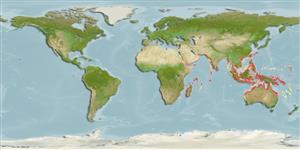Environment: milieu / climate zone / depth range / distribution range
Ecologia
marinhas; estuarina; intervalo de profundidade 1 - 20 m (Ref. 6898). Tropical; 28°N - 40°S, 21°E - 170°E (Ref. 189)
Indo-Pacific: India Ocean from Gulf of Oman south to Port Alfred, but no records from the Red Sea and Madagascar; coasts of Pakistan, India and probably Burma; Thailand, Indonesia, Philippines to Taiwan (Ref. 189), including Arafura Sea (Ref. 9819); also northern Australia, Papua New Guinea, Solomon Islands and New Hebrides (Ref. 189).
Comprimento de primeira maturação / Tamanho / Peso / Idade
Maturity: Lm 16.0 range ? - ? cm
Max length : 18.0 cm SL macho/indeterminado; (Ref. 9822); common length : 15.0 cm SL macho/indeterminado; (Ref. 9822)
Espinhos dorsais (total) : 0; Raios dorsais (total) : 14 - 16; Espinhos anais: 0; Raios anais : 32 - 39. Diagnosis: Body fairly compressed, belly with 16-18 plus 9-10, with a total of 25-28 keeled scutes; lower gill rakers 10-12; head with gold tints; anal and caudal fins deep yellow; a black area behind upper part of gill opening (Ref. 189). It is distinguished from all other Thryssa species and in fact all other anchovies by the very long maxilla, reaching at least to tip of pectoral fin, usually to pelvic fin base or even to anal fin origin; also unique is the high coronoid process of the lower jaw, the jaw rising steeply in the mouth (Ref. 189).
Marine, pelagic, presumably schooling, occurring mostly close inshore, entering bays and estuaries (Ref. 189, 30573). Recorded at a temperature range of 26.0-29.0 °C in the Trinity Inlet system, Australia (Ref. 4959). It feeds mainly on crustaceans, like amphipods, zoea larvae, Acetes (Ref. 189, 30573). May be caught using ringnets (Ref. 5213). Used as bait in the tuna fishery in the South Pacific.
Ciclo de vida ou comportamento de acasalamento
Maturidade | Reprodução | Desova | Ovos | Fecundidade | Larvas
Wongratana, T., T.A. Munroe and M. Nizinski, 1999. Order Clupeiformes. Engraulidae. Anchovies. p. 1698-1753. In K.E. Carpenter and V.H. Niem (eds.) FAO species identification guide for fishery purposes. The living marine resources of the WCP. Vol. 3. Batoid fishes, chimaeras and bony fishes part 1 (Elopidae to Linophrynidae). FAO, Rome. (Ref. 9822)
Status na Lista Vermelha da UICN (Ref. 130435: Version 2024-2)
Ameaça para os humanos
Harmless
Uso pelos humanos
Pescarias: pouco comercial; isca: usually
Ferramentas
Relatórios especiais
Baixar XML
Fontes da internet
Estimates based on models
Preferred temperature (Ref.
123201): 24.9 - 29.3, mean 28.5 °C (based on 3124 cells).
Índice de diversidade filogenética (Ref.
82804): PD
50 = 0.5000 [Uniqueness, from 0.5 = low to 2.0 = high].
Bayesian length-weight: a=0.00776 (0.00481 - 0.01252), b=3.09 (2.96 - 3.22), in cm total length, based on LWR estimates for this species & (Sub)family-body (Ref.
93245).
Nível Trófico (Ref.
69278): 3.3 ±0.48 se; based on food items.
Generation time: 2.7 ( na - na) years. Estimated as median ln(3)/K based on 2
growth studies.
Resiliência (Ref.
120179): Elevada, tempo mínimo de duplicação da população menor que 15 meses (Preliminary K or Fecundity.).
Fishing Vulnerability (Ref.
59153): Low vulnerability (11 of 100).
Nutrients (Ref.
124155): Calcium = 204 [124, 477] mg/100g; Iron = 1.55 [0.84, 2.70] mg/100g; Protein = 19 [18, 20] %; Omega3 = 0.449 [0.226, 0.957] g/100g; Selenium = 27.8 [13.5, 59.9] μg/100g; VitaminA = 24.7 [6.9, 69.6] μg/100g; Zinc = 1.99 [1.37, 2.86] mg/100g (wet weight);
